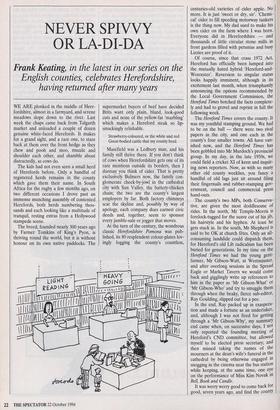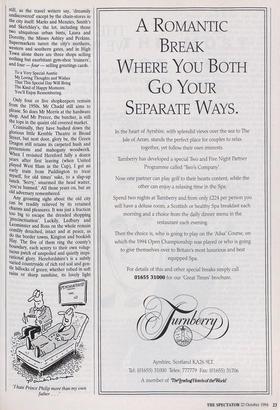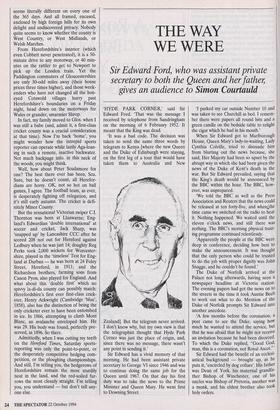NEVER SPIVVY OR LA-DI-DA
Frank Keating, in the latest in our series on the
English counties, celebrates Herefordshire, having returned after many years
WE ARE plonked in the middle of Here- fordshire, almost in a farmyard, and serene meadows slope down to the river. Last week the chaps came back from Talgarth market and unloaded a couple of dozen genuine white-faced Herefords. It makes for a grand sight, and a rare one, to stare back at them over the front hedge as they chew and pooh and moo, muzzle and shoulder each other, and shamble about distractedly, as cows do.
The kids had not even seen a small herd of Herefords before. Only a handful of registered herds remains in the county which gave them their name. In South Africa for the rugby a few months ago, on two different occasions I drove past an immense munching assembly of contented Herefords, both herds numbering thou- sands and each looking like a multitude of tranquil, resting extras from a Hollywood stampede scene.
The breed, founded nearly 300 years ago by Farmer Tomkins of King's Pyon, is thriving round the world, but it is without honour on its own native paddocks. The supermarket buyers of beef have decided Brits want only plain, bland, look-good cuts and none of the yellow-fat 'marbling' which makes a Hereford steak so lip- smackingly relishable.
Strawberry-coloured, or the white and red Great-bodied cattle that my county bred.
Masefield was a Ledbury man, and his family still thrive there. If you don't think of cows when Herefordshire gets one of its rare mentions outside its borders, then I daresay you think of cider. That is pretty exclusively Bulmers now, the family con- glomerate cheek-by-jowl in the cathedral city with Sun Valley, the battery-chicken chain; the two are the county's largest employers by far. Both factory chimneys scar the skyline and, possibly by way of apology, each company does earnest civic deeds and, together, seem to sponsor every jumble-sale or jogger that moves.
At the turn of the century, the wondrous classic Herefordshire Pomona was pub- lished, its 80 resplendent colour-plates lov- ingly logging the county's countless, centuries-old varieties of cider apple. No more. It is just 'sweet or dry, sir'. 'Chemi- cal' cider to fill speeding motorway tankers is the thing now. My dad used to make his own cider on the farm where I was born. Everyone did in Herefordshire — and thousands of little circular stone mills in front gardens filled with petunias and busy Lizzies are proof of it.
Of course, since that crass 1972 Act, Hereford has officially been lumped into the mutually hated hybrid 'Hereford-and- Worcester'. Reversion to singular status looks happily imminent, although in its excitement last month, when triumphantly announcing the options recommended by the Local Government Commission, the Hereford Times botched the facts complete- ly and had to grovel and reprint in full the following week.
The Hereford Times covers the county. It was my youthful stamping ground. We had to be on the ball — there were two rival papers in the city, and one each in the county's four smaller towns. All have van- ished now, and the Hereford Times has been gobbled into Mr Murdoch's provincial group. In my day, in the late 1950s, we could field a cricket XI of keen and inquir- ing news reporters. Now, as with so many other old county weeklies, you fancy a handful of old lags just sit around filing their fingernails and rubber-stamping gov- ernment, council and commercial press hand-outs.
The county's two MPs, both Conserva- tive, are given the most doddlesome of rides. In the north, Mr Temple-Morris is forelock-tugged for the suave cut of his jib, his hairstyle and his hyphen. At least he gets stuck in. In the south, Mr Shepherd is said to be OK at church fetes. Only an all- consuming landslide could dispatch them, for Hereford's old Lib radicalism has been buried for generations. In my time on the Hereford Times we had the young gent- farmer, Mr Gibson-Watt, at Westminster, and after overlong sessions in the Spread Eagle or Market Tavern we would come back and gigglingly write up references to him in the paper as 'Mr Gibson-What' or `Mr Gibson-Who' and try to smuggle them through when the beaky, fierce sub-editor, Ray Goulding, slipped out for a pee.
In the end, Ray packed up in exaspera- tion and made a fortune as an undertaker, and, although I was not fired for getting through a 'Mr Gibson-Why', my summary end came when, on successive days, I not only reported the founding meeting of Hereford's CND committee, but allowed myself to be elected press secretary; and then missed taking the names of the mourners at the dean's wife's funeral in the cathedral by being otherwise engaged in snogging in the cinema near the bus station while keeping, at the same time, one eye on the performance of Miss Kim Novak in Bell Book and Candle. It was werry werry good to come back for good, seven years ago, and find the county still, as the travel writers say, 'dreamily undiscovered' except by the chain-stores in the city itself: Marks and Menzies, Smith's and Sketchley's, the lot, including those two ubiquitous urban bints, Laura and Dorothy, the Misses Ashley and Perkins. Supermarkets turret the city's northern, western and southern gates, and in High Town alone there are three shops selling nothing but exorbitant gym-shoe 'trainers', and four —four — selling greetings cards.
To a Very Special Auntie My Loving Thoughts and Wishes That This Special Day Will Bring The Kind of Happy Moments You'll Enjoy Remembering.
Only four or five shopkeepers remain from the 1950s. Mr Chadd still aims to please. So does Mr Morris at the hardware shop. And Mr Preece, the butcher, is still the tops in the quaint old covered market. Criminally, they have bashed down the glorious little Kemble Theatre in Broad Street, but next door, glory be, the Green Dragon still retains its carpeted hush and pretensions and mahogany woodwork. When I revisited Hereford fully a dozen years after first leaving (when United played West Ham in the Cup), I got an early train from Paddington to treat myself, for old times' sake, to a slap-up lunch. 'Sorry,' smarmed the head waiter, 'you're banned.' All those years on, but an old adversary remembered. Any groaning sighs about the old city can be readily relieved by its retained charms and pleasures. It was just a fraction too big to escape the dreaded shopping precinctisation'. Luckily, Ledbury and Leominster and Ross on the whole remain cnmfily detached, intact and at peace, as do the border towns, Kington and bookish Hay. The five of them ring the county's boundary, each sentry to their own volup- tuous patch of unspoiled and quietly inspi- rational glory. Herefordshire's is a subtly varied countryside of rich red soil and gen- tle hillocks of green; whether robed in soft rains or sharp sunshine, its lovely light I hate Prince Philip more than my own father . . seems literally different on every one of the 365 days. And all framed, encased, enclosed by high foreign hills for its own delight and undiscovered privacy. Nobody quite seems to know whether the county is West Country, or West Midlands, or Welsh Marches.
From Herefordshire's interior (which even Cobbett never penetrated), it is a 50- minute drive to any motorway, or 40 min- utes on the rattler to get to Newport to pick up the London train. Yet the Paddington commuters of Gloucestershire are only 30-odd miles away (their house prices three times higher), and those week- enders who have not changed all the hon- eyed Cotswold villages hurry past Herefordshire's boundaries on a Friday night, head down on the motorways for Wales or grander, smarmier Shrop.
In fact, my family moved to Glos. when I was still a babe (and, admit it, a first-class cricket county was a crucial consideration at that time). Now I'm back `home', you might wonder how the intrepid sports reporter can operate while lazily Aga-lean- ing in such a remote, inactive backwater. Not much backpage info. in this neck of the woods, you might think.
Well, how about Peter Scudamore for one? The best there ever has been, Scu. Sure, but he doesn't count, all Herefor- dians are horsy. OK, not so hot on ball games, I agree. The football team, as ever, is desperately fighting off relegation, and it's still early autumn. The cricket is defi- nitely Minor County.
But the sensational Victorian swiper C.I. Thornton was born at Llanwarne; Eng- land's Edwardian `double international' at soccer and cricket, Jack Sharp, was `snapped up' by Lancashire CCC after he scored 208 not out for Hereford against Ledbury when he was just 14; doughty Reg Perks took 2,000 wickets for Worcester- shire, played in the `timeless' Test for Eng- land at Durban — he was born at 24 Foley Street, Hereford, in 1911; and the Richardson brothers, farming sons from Canon Pyon, also played for England. And what about this `double first' which no spivvy la-di-da county can possibly match: Herefordshire's first ever first-class crick- eter, Henry Arkwright (Cambridge `blue', 1858), also has the distinction of being the only cricketer ever to have been entombed in ice. In 1866, attempting to climb Mont Blanc, an avalanche enveloped him. He was 29. His body was found, perfectly pre- served, in 1896. So there.
Admittedly, when I was cutting my teeth on the Hereford Times, Saturday sports- reporting was only the point-to-point, or the desperately competitive hedging com- petition, or the ploughing championships. And still, I'm telling you, the hedgerows of Herefordshire remain the most sturdily neat in the land, and the red-soiled fur- rows the most cleanly straight. I'm telling you, you understand — but don't tell any- one else.












































































 Previous page
Previous page